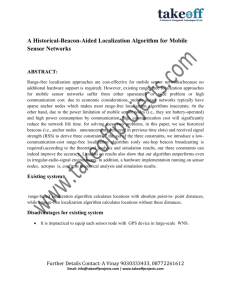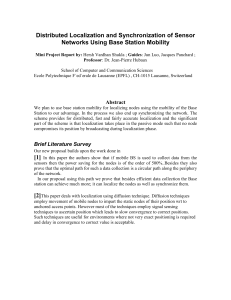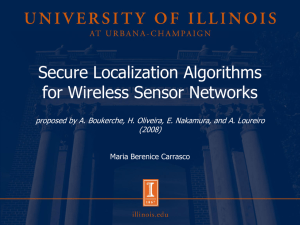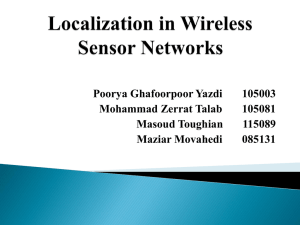Localization in Anchor less Wireless sensor Network Mehdi Vojdani , Mehdi Dehghan
advertisement
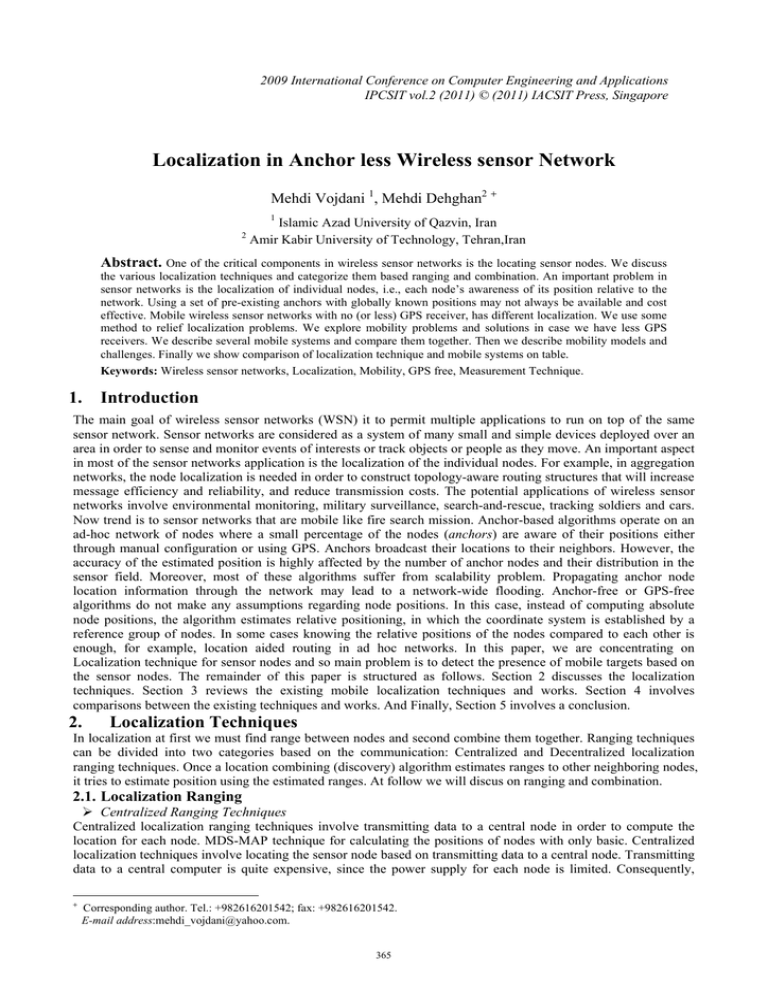
2009 International Conference on Computer Engineering and Applications IPCSIT vol.2 (2011) © (2011) IACSIT Press, Singapore Localization in Anchor less Wireless sensor Network Mehdi Vojdani 1, Mehdi Dehghan2 + 1 2 Islamic Azad University of Qazvin, Iran Amir Kabir University of Technology, Tehran,Iran Abstract. One of the critical components in wireless sensor networks is the locating sensor nodes. We discuss the various localization techniques and categorize them based ranging and combination. An important problem in sensor networks is the localization of individual nodes, i.e., each node’s awareness of its position relative to the network. Using a set of pre-existing anchors with globally known positions may not always be available and cost effective. Mobile wireless sensor networks with no (or less) GPS receiver, has different localization. We use some method to relief localization problems. We explore mobility problems and solutions in case we have less GPS receivers. We describe several mobile systems and compare them together. Then we describe mobility models and challenges. Finally we show comparison of localization technique and mobile systems on table. Keywords: Wireless sensor networks, Localization, Mobility, GPS free, Measurement Technique. 1. Introduction The main goal of wireless sensor networks (WSN) it to permit multiple applications to run on top of the same sensor network. Sensor networks are considered as a system of many small and simple devices deployed over an area in order to sense and monitor events of interests or track objects or people as they move. An important aspect in most of the sensor networks application is the localization of the individual nodes. For example, in aggregation networks, the node localization is needed in order to construct topology-aware routing structures that will increase message efficiency and reliability, and reduce transmission costs. The potential applications of wireless sensor networks involve environmental monitoring, military surveillance, search-and-rescue, tracking soldiers and cars. Now trend is to sensor networks that are mobile like fire search mission. Anchor-based algorithms operate on an ad-hoc network of nodes where a small percentage of the nodes (anchors) are aware of their positions either through manual configuration or using GPS. Anchors broadcast their locations to their neighbors. However, the accuracy of the estimated position is highly affected by the number of anchor nodes and their distribution in the sensor field. Moreover, most of these algorithms suffer from scalability problem. Propagating anchor node location information through the network may lead to a network-wide flooding. Anchor-free or GPS-free algorithms do not make any assumptions regarding node positions. In this case, instead of computing absolute node positions, the algorithm estimates relative positioning, in which the coordinate system is established by a reference group of nodes. In some cases knowing the relative positions of the nodes compared to each other is enough, for example, location aided routing in ad hoc networks. In this paper, we are concentrating on Localization technique for sensor nodes and so main problem is to detect the presence of mobile targets based on the sensor nodes. The remainder of this paper is structured as follows. Section 2 discusses the localization techniques. Section 3 reviews the existing mobile localization techniques and works. Section 4 involves comparisons between the existing techniques and works. And Finally, Section 5 involves a conclusion. 2. Localization Techniques In localization at first we must find range between nodes and second combine them together. Ranging techniques can be divided into two categories based on the communication: Centralized and Decentralized localization ranging techniques. Once a location combining (discovery) algorithm estimates ranges to other neighboring nodes, it tries to estimate position using the estimated ranges. At follow we will discus on ranging and combination. 2.1. Localization Ranging ¾ Centralized Ranging Techniques Centralized localization ranging techniques involve transmitting data to a central node in order to compute the location for each node. MDS-MAP technique for calculating the positions of nodes with only basic. Centralized localization techniques involve locating the sensor node based on transmitting data to a central node. Transmitting data to a central computer is quite expensive, since the power supply for each node is limited. Consequently, + Corresponding author. Tel.: +982616201542; fax: +982616201542. E-mail address:mehdi_vojdani@yahoo.com. 365 communication with a centralized computing is expensive, and sending time series data within the network introduces latency, and it also consumes energy and network bandwidth ¾ Decentralized Ranging Techniques Decentralized ranging techniques depend on each node being able to determine its location and don’t require centralized computation. Distributed techniques involve: Range-based and Range-free localization techniques. [1] Range-based Localization Techniques: Range-based localization techniques involve finding the location of the target sensor node using absolute point-to-point distance estimates or angle estimates. Range-based localization techniques involve many techniques such as Time or Arrival (TOA), Angle of Arrival (AOA), Time Difference of Arrival (TDoA), received signal strength (RSS), GPS, AHLoS, and CRB. a. TOA: is commonly used as a mean of obtaining range via signal propagation time, and it’s depend on the time difference. TOA needs a high clock resolution to obtain accurate position estimates. b. AOA: obtaining angle between nodes use multi antenna and radio frequency. Difference time of arrive and phase use for finding angle between two nodes. Commonly its used 3-4 antenna and so we can use optical communication for this purpose. c. TDoA: is used with microphone and speaker for finding distance. Special hardware in this method is important. First sensor sent radio frequency then sent sound plus. With determine time difference between two plus we can find distance between two nodes. d. RSS: is commonly used obtaining range information via signal strength and it’s depend on the power of received signal that related with distance. RSS accuracy depends on environment noise. e. RSSI: Received-Signal-Strength-Indicator methods measure the power of the signal at the receiver. Based on the known transmission power, the effective propagation loss can be calculated. Theoretical and empirical models are used to translate this loss into a distance estimate. f. AHLoS: is a localization system, its based on a set of distributed iterative algorithms. AHLoS technique depends on limited fraction of nodes with known positions and its deploy TOA. g. CRB: localization technique that involves estimating the location when sensors measure RSS or TOA. Range-based techniques are a decentralized and give accurate and precise localization information. [2] Range-free Localization Techniques: we can use alternative range free solutions for localization problems. Range free localization involves using regular radio modules as a basis for localization and is dependent only on the content of the received message. They, therefore, they do not require any additional hardware and so are cost and energy efficient. These techniques are Local and Hop counting method. a. Local Techniques: These techniques rely on a high density of beacons, so that every node can hear from several beacons. Centroid technique for every small, low cost devices and no need for GPS. It’s based on spherical radio propagation assumption. Each node estimates by measuring the centre of the location of all nodes it hears. APIT needs a heterogeneous network of sensing devices where a small percentage of beacon nodes. APIT involves dividing environment into triangular. b. Hop Counting Techniques: These rely on flooding and involve providing localization where nodes density is low. DV-HOP technique, which involves that each node maintains a counter of denoting the minimum number of hops to each node, and then update the counter based on the received message. 2.2. Range Combining Technique Once a location discovery algorithm estimates ranges to other neighboring nodes, it tries to estimate node position using the estimated ranges. The most known techniques for combining ranges are: • Trilateration. Trilateration locates a node by calculating the intersection of three circles as shown in Figure 1a. If the ranges contain error, the intersection of the three circles may not be a single point. • Triangulation. Triangulation is used when angle of the node is estimated as in AoA. Node positions are calculated by trigonometry laws of sines and cosines. So at least two ranges are required as shown in Figure 1b. • Multilateration. In multilateration, the position is estimated from distances to three or more known nodes by minimizing the error between estimated and actual position. For example, in Figure 1c. • Proximity-based. Proximity-based is used when no range information is available. Position of a node is taken as the centroid of positions of connected anchors. An anchor node is considered connected to a node if the percentage of messages received from the anchor node in a time interval t exceeds a threshold. Figure 1: Range Combining Techniques: (a) Trilateration, (b) Triangulation, (c) Multilateration 366 3. Mobile Localization Techniques 3.1. Overview A majority of research works related to localization problems have focused on static networks [3]. Recently, however, more attention has been paid to mobile environments. Problems in mobile sensor networks have been investigated mainly in conjunction with a particular positioning infrastructure (anchors or beacons) or under random movement scenarios [5]. Solutions traditionally rely on two assumptions:(1) the availability of global positioning systems (GPS) which requires additional hardware at additional costs. (2) the availability of a number of fixed-point reference nodes, or anchors, with globally known locations [25]. This is most commonly used in static networks [3] with recent efforts on mobile networks where a small subset of the moving nodes (seeds) is aware of their global positions [9]. To support mobility applications, a node must move in a specific direction in a manner that is related to its neighbors. We call directional localization the problem of determining both the position and the orientation of each sensor in the common coordinate system. Many applications require mobility where GPS and pre-existing infrastructures do not exist. Consider a fire search mission inside a building where a set of mobile nodes explore a floor with the goal to locate the source of fire. The nodes move collaboratively, in a semi-rigid swarm. Swarm follows a path such that it covers the area while taking temperature measurements. Low precision for close range and limited coverage (especially indoors) of GPS systems led researchers to explore GPS-free localization for mobile nodes. One common technique used is to exploit wireless communication. Bulusu et al. [2] use known reference points to send periodic beacon messages. By receiving beacons from enough sources, nodes can localize themselves. The accuracy of the localization depends on the distance to the reference points. Priyantha et al. [3] also use beacons for localization, but they assume the real locations of the reference points are unknown. The problem of calculating global geometry from local information is proved to be NP-hard [16]. For static nodes, and only using Euclidean distances, B˘adoiu et al. [24] propose a constant factor, quasipolynomial-time approximation algorithm. The algorithm requires complete graph information, and is not practical for low processing power nodes. In [5], relative localization in mobile sensor networks is accomplished through triangulation of neighbor nodes using a common one-hop neighbor. The authors propose algorithms for building a relative coordinate system based on a central node, or a dense group of nodes called Location Reference Group. Although this work estimates positioning in a mobile environment without seed nodes, its primary focus is on negotiating a relative coordinate system for the entire network. While this solution finds applications in routing protocols, it is not applicable in mobility scenarios where directed motion is required. In [9] a sequential Monte Carlo is used to probabilistically estimate with a few seeds. Seeds are those nodes which know their precise location, through the use of GPS, for example. Due to the model’s dependence on the previous estimates, the location errors are cumulative and a re-sampling step must be introduced. The re-sampling process requires each node to collect as much as fifty samples before a good estimate can be made. A method based on predictions is in [26], where nodes in the network use a dead reckoning model to estimate the movements of all other nodes. Position information is adjusted for granularity so that distant pairs of nodes maintain less accurate information than pairs which are closer to each other. Concerning distance and motion error, Rayleigh fading may introduce significant errors due to the motion where RSS is used for neighbor distance estimation. This problem is studied in [23], where estimation is based on power measurement of signals received from two beacons. They explore how the speed of nodes detrimentally affects their localization accuracy. In [4] directional localization algorithm is where the entire network must move in a specific path in order to accomplish a goal for mobile applications. They used a mobility model based on Reference Point Group Mobility (RPGM) for algorithm. In the RPGM model, the random motion of the individual nodes is modeled in relation to a randomly chosen directional motion of the entire group. Each node moves randomly around a fixed reference and the entire group of reference points moves along the group’s logical center. Algorithm computes locations and orientations for nodes and their neighbors and the neighbors represent the reference points of motion. 3.2. Mobility Models Mobility models for sensor network categorized two models, first for one mobile node (entity mobility) and second for group of mobile nodes (group mobility). 1) Entity Mobility Models: Random Walk Mobility Model (including its many derivatives) is a simple mobility model based on random directions and speeds. Random Waypoint Mobility Model that includes pause times between changes in destination and speed. A Probabilistic Version of the Random Walk Mobility Model is a model that utilizes a set of probabilities to determine the next position of a mobile node. City Section Mobility Model has simulation area that represents streets within a city. 2) Group Mobility Models: Exponential Correlated Random Mobility Model is a group mobility model that uses a motion function to create movements. Column Mobility Model used where the set of nodes form a line and are uniformly moving forward in a particular direction. Nomadic Community Mobility Model used where a set of nodes move together from one location to another. Pursue Mobility Model that a set of nodes follow a given target. Reference Point Group Mobility Model is a group mobility model where group movements are based upon the path traveled by a logical center. For example in Figure 2 you can see group mobility. 367 Figure 2: group mobility on specific direction. The performance of network protocol can vary with different models and in specific model used with different parameters this lead to different performance results. Choosing a model may require a data traffic pattern which significantly influences protocol performance. For example group mobility model done with a portion of the traffic local to the group. The performance of a protocol should be evaluated with model that closely matches the expected real-world scenario. Other mobility models, as surveyed in [27]. If a group mobility model is desired, recommendation is using the Reference Point Group Mobility Model. If an entity mobility model is desired, recommendation using either the Random Waypoint Mobility Model. Implementations of all the mobility models described are available at [28]. Develop a new model that combines the best attributes of the models is needed. 3.3. Challenges For most applications, sensor nodes are supposed to be randomly deployed, preventing any pre-configuration of the network. In addition, networks are mainly characterized by a highly dynamic topology, due to level of node failures (e.g. energy). The implementation of self-configuration mechanisms then become a requirement in order to be able to guarantee an efficient transmission of the localization information is needed. Self-configuration is useful in node organization and network self optimization. Self optimization is to take into account application requirements prior to operation and pre-configure/pre-optimize the protocol parameters. This is simply insufficient in sensor networks when envoriment inherently is unpredictable. In a powerful design we must embrace the use of autonomous learning through observations, so that network localization can optimize their own performance over time. Current techniques attempt to localize nodes prior to operation based on communication constraints or ranging estimates. Target tracking introduce additional constraints that can be used to further reduce the localization error over time. Technique suitable for querying about targets or pushing data to sinks that have an underlying (unknown) probabilistic location pattern. Other issues in localization with mobility are: a. Performance and Requirements: The accuracy of the location, the delay in making the location estimation, the capacity (how many requests for location estimation can be processed) and coverage. Requirements will influence the nature of the localization system deployed. In self- localization systems, the mobile node has to perform additional computation and processing that could affect its battery life. b. Cost and complexity: Deploying systems will require additional costs on top of the communications infrastructure. The costs arise from the infrastructure, need for additional bandwidth for localization purposes only. The infrastructure cost could be reduced by having an umbrella localization system that covers a large area for use in several applications, especially in dense urban and indoor areas. d. Security: Privacy of location information is considered essential as this could provide extensive knowledge of the activities of any individual whose location can be continually tracked. Here it is very difficult to secure such signals. It may be possible to develop security protocols to prevent unauthorized sources. When mobile nodes move across boundaries of control, the security of their information becomes more important. 4. Comparisons There are many localization techniques that have been mentioned above. In this section, the localization techniques are evaluated based on four factors. Table 1: involves a comparison between centralized and decentralized techniques based on five factors, Table 2: involves a comparison between range-based and rangefree localization techniques. Cost involves the installation of and the system’s administration needs together with capital costs which involve factors such as the price per mobile unit or infrastructure element. Accuracy the main goal for any localization technique is to be able track the mobile target. Power-consuming it is an important factor, because each sensor node has limited power and it is hard to change the sensors’ battery frequently. Dependence on Special hardware the tracking technique depends on the sensor’s characteristics. Table 3: involve a comparison between references work on Localization in mobile wireless sensor network on five factors. Ad hoc involves the nodes connection, coordination and topology in localization. Measurement technique involves which technique used to measuring distance between nodes. Anchor or GPS free is for determining algorithm depends on fix anchor point or GPS device. Centralized and Decentralized involved which technique used. At last mobility is premiere than other determines degree of mobility in algorithm that has three options less, medium and full. Table 1: Centralized and Decentralized Technique 368 Comparison Cost Power Consuming Accuracy Special Hardware Centralized Expensive Powerconsumed medium Don’t Require Decentralized Inexpensive Powerefficient high Don’t Require [7] Table 2: Range-Based and Range-Free Technique Comparison Cost RangeBased Range-Free Expensive Inexpensive Power Consuming Powerconsumed Powerefficient Accuracy high medium Special Hardware Don’t Require Require Table 3: Comparison between References Work Local technique no Local technique [4] Yes TOA [5] yes TOA [6] No Local technique(MCL) No TOA & RSS [11] No RSSI [12] No RSSI [13] No DV HOP [14] No TDOA [15] yes HOP Terrain medium Decentralized Medium Centralized less Centralized medium Decentralized Full Decentralized less Decentralized medium Decentralized less Decentralized medium Decentralized less Decentralized medium medium [18] Yes DV HOP Decentralized less [19] Yes AOA medium medium Anchor Base Decentralized Decentralized [20] Yes HOP Terrain less Full [21] No RSSI Decentralized Less Decentralized medium Anchor Base Anchor Base Decentralized Decentralized [22] No TDOA less less [23] No RSS Anchor Base Anchor Base Decentralized Decentralized Decentralized Less Decentralized No [10] Decentralized DV HOP One Anchor No Anchor No Anchor No Anchor No Anchor Anchor Based [3] RSS TOA & RSS RSS [2] Hop Counting No Less No mobility No No [9] Decentralized Yes Centralized or Decentralized [1] [8] Anchor Based Anchor Based Anchor Based Anchor Based Anchor Based One Anchor Anchor Based No Anchor Anchor Base Anchor Base Anchor Base Both [17] Anchor or GPS free Adhoc RSS [16] Measurement technique Algorithm Or reference No 5. Conclusion Localization is a vital area in wireless sensor applications. The location tracking techniques have been categorized and evaluated in the previous section. As seen before, most of the techniques are based on additional hardware, in order to detect and track the position of the mobile targets. We discuss the various location system techniques and categorize these techniques based on the communication between nodes. An important problem in mobile ad-hoc wireless sensor networks is the localization of individual nodes, i.e., ach node’s awareness of its position relative to the network. We discuss anchor less mobile localization system that they were implemented. As we see many work are deployed in this case but 3-6 work are good. We explore mobility challenges and compare works on one table together and we see [4] work better of other and his cost is less in deploy. 6. References [1] Khan, H.M. Olariu, S. Eltoweissy, M. Efficient single-anchor localization in sensor networks, DSSNS, page(s): 9-14 , 2006. [2] N.Bulusu,J. Heideman,D.Estrin.Gps-less low cost outdoor localization for small device,IEEE Communication,pages28-34, 2000. [3] N. B. Priyantha, H. Balakrishnan, E. Demaine. Anchor-free distributed localization in WSN. SenSys03, pages 340–341. [4] H. Akcan ,V, Kriakov ,H,Brönnimann ,A,Delis .GPS-Free node localization in mobile wireless sensor networks, 5th ACM international workshop on Data engineering for wireless and mobile access Pages: 35 - 42 , ,2006. [5] S. Capkun, M. Hamdi. GPS-free Positioning in Mobile Ad Hoc Networks. Cluster Computing, 5(2):157–167, 2002. [6] S. Navarro, E.Viveknandan,V. Wong, Dual Mixture MCL Algorithms for Mobile WSN, WCNC 2007. page(s): 4024-4028. [7] A. Baggio, K. Langendoen, Monte-Carlo Localization for Mobile Wireless Sensor Networks, MSN 2006, page:317–328, 2006. [8] Yi, Jiyoung Yang, Sungwon Cha, Hojung. Multi-hop-based MCL for Mobile Sensor Networks, SECON '07. page(s): 162-171. [9] L. Hu and D. Evans. Localization for mobile sensor networks. In MOBICOM, pages 45–57, 2004. [10] J.A. Costa ,N. Patwari, A.Hero, Distributed weighted-MDS for node localization in WSN, TOSN06 , pages: 39 – 64. [11] Xiang Ji Hongyuan Zha, Sensor positioning in wireless ad-hoc networks using MDS, INFOCOM 2004, pages: 2652- 2661. [12] M. Sichitiu and V. Ramadurai, Localization of wireless sensor networks with a mobile beacon, MASS2004, page:174–183. [13] R.Stoleru ,J.Stankovic,S.Son, Robust node localization for WSN, Embedded Networked sensors, Pages: 48 –52, 2007. [14] D. Moore ,J. Leonard,D. Rus, S.Teller, Robust distributed network localization with noisy range measurements, Embedded networked sensor, USA ,Pages: 50 – 61, 2004. [15] C.Savarese,j.Rabaey,K.Langendoen.Robust Positioning Algorithms for Distributed Ad-Hoc WSN, USENIX02 Pages:317-327. [16] Yi-Ling Hsieh; Kuochen Wang. Efficient Localization in Mobile WSN, Ubiquitous Computing, Page(s): 292 – 297, 2006. [17] A. Savvides C Han M.Strivastava, Dynamic fine-grained localization in Ad-Hoc WSN, Mobile computing, Pages: 166-179, 2001. [18] Niculescu, D.; Nath, B. Ad hoc positioning system (APS). GLOBECOM 2001 Page(s):2926 – 2931, 2001. [19] Niculescu, D. Nath, B. Localized positioning in ad hoc WSN Protocols and Applications,.IEEE Workshop pages: 42-50, 2003. [20] C. Savarese, J Rabaey, & J. Beutel. Locationing in distributed ad-hoc wireless sensor networks,” In ICASSP, 2001. [21] G. S. Paschos, E. D. Vagenas. Real-time Localization for WSN with multiple beacon transmissions, Samos, 2005. [22] Priyantha, N.B.Balakrishnan, H.Demaine, E.D.Teller. Mobile-assisted localization in WSN, INFOCOM 2005. pages: 172-183. [23] P. Bergamo and G. Mazzini. Localization in WSN with Fading and Mobility. Indoor Radio Communications, pages 750–754, 2002. [24] M. Badoiu, E.Demaine,. Low-dimensional embedding with extra information,Computational Geometry,pages 320–329, 2004. [25] K. Chintalapudi, R. Govindan, G. Sukhatme. Ad-Hoc Localization Using Ranging and Sectoring.INFOCOM, 2004. [26] V. Kumar and S. R. Das. Performance of dead reckoning-based location. Wireless and Mobile Computing, pages:189–202, 2004. [27] T. Camp, J.Boleng,V. Davies. A survey of mobility models for ad hoc networks,Wireless Mobile Computing, 2(5):483–502, 2002. [28] http://toilers.mines.edu 369
